Summary:
- The 2024 McLaren MCL38 F1 car has achieved a perfect balance between power and control, making it a top contender in the field.
- Key performance improvements include refined aerodynamics, chassis and suspension improvements, better engine efficiency, and new technological innovations.
- McLaren's aerodynamics mastery allows for exceptional downforce balance, enabling smooth, fast speeds and stable handling in corners.
- In sim-racing, adjusting settings like ride height and suspension helps replicate the MCL38’s real-world performance, allowing racers to fine-tune their cars for different tracks.
- The car’s design innovations and engine mapping strategies also provide a competitive edge, making it a favorite in both real and virtual racing worlds.
For fans of Formula One, the 2024 season is probably the most exciting in years. Red Bull Racing no longer has the outright dominant car in the field—thanks to McLaren.
The 2024 McLaren MCL38 F1 car has emerged as the most advanced and balanced cars the sport has seen in nearly two years, as well as one of the outright fastest this year. Through iterations, upgrades, and sheer hard work, it has become a marvel of balanced performance.
But what makes the MCL38 one of the greatest F1 cars of recent memory? And more importantly, how do its features translate to the world of sim-racing so you can enjoy the ultimate simulated racing experience?
We’re here to tell you. Gear up and read on.
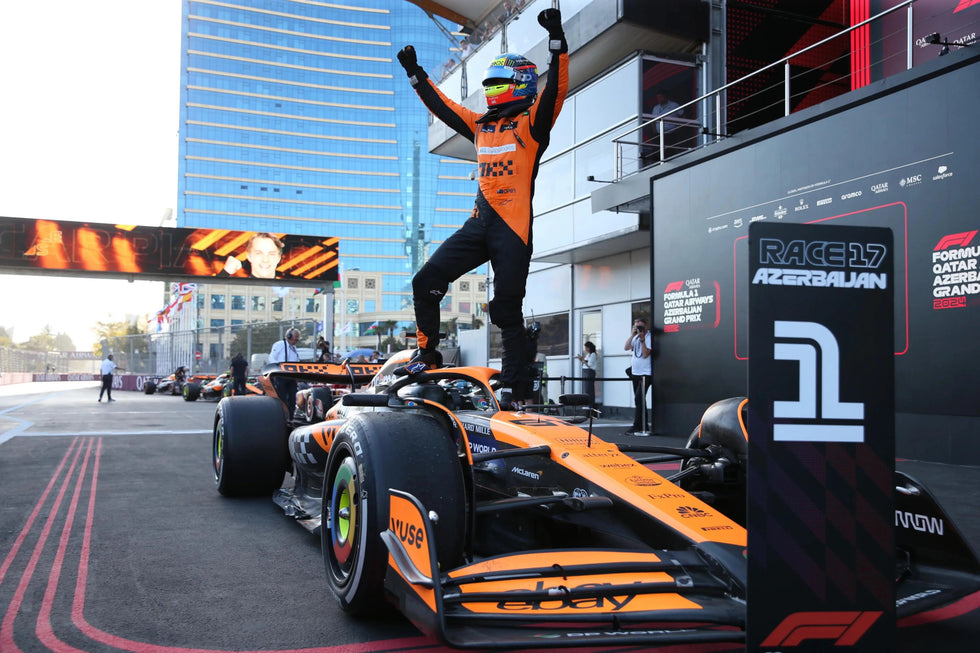
An In-Depth Look At the 2024 McLaren MCL38
One of the things about Formula One that makes it exciting is that no two cars are ever the same. The FIA passes down certain specifications about dimensions, fuel flow, power output, and the hybrid electrical system (aka the Formula part of the name), but each team is then free to design a car that meets all of those specifications.
There are also about a million other little things to consider: complex aerodynamics, drag-to-power ratios, how much cooling needs to go where in order to optimize thermal efficiency, and more.
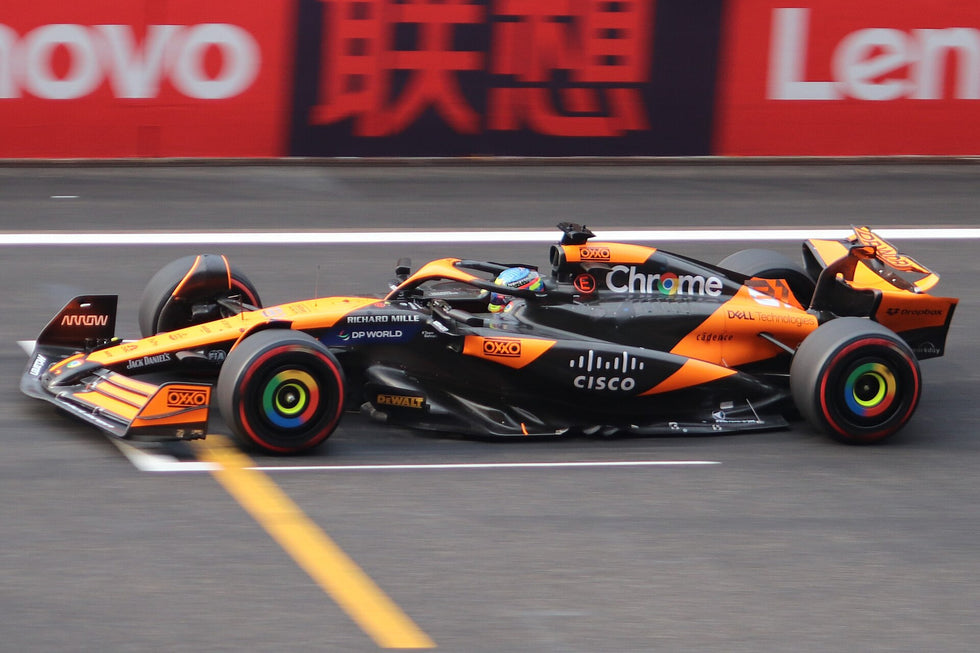
McLaren’s car this year is not only within those specifications but has absolutely nailed the perfect balance between power and control. There are four major areas where it has left the rest of the field in its tire tracks and made the papaya car nearly unbeatable:
- Aerodynamics
- Chassis and suspension
- Engine and hybrid system
- New ideas, innovations, and technology
Aerodynamics
The MCL38 is the first McLaren F1 car to be fully designed and tested in-house, using their just-completed wind tunnel on the McLaren Technology Center campus in Woking, England.
While it may not look all that much different from the MCL37 from 2023, the fact of the matter is that apart from the main safety cell, almost every panel, screw, nut, and bolt of the MCL38 was brand new for 2024.
It is these small but significant changes that affected the aerodynamics of the car in a positive way, making it incredibly slippery through the air but also maximizing the key “boundary effect” that F1 cars rely on to shove their cars down into the road.
Keep in mind: this next section is a simplified explanation of Formula One aerodynamics, but it will also be the most technical part of our look at the MCL38!
Body Aerodynamics on the MCL38
Here’s the most basic way to describe an extremely complex bit of physics: the faster a certain volume of air moves over a surface, the lower the pressure of that air is. However, another small layer of air gets trapped between the moving air and the surface it’s moving over, effectively getting “stuck” to said surface. This air creates a small but incredibly smooth layer for the moving air to glide across known as a “boundary layer”.
The more stable you can make that layer, the faster and more smoothly it allows the air to glide over it, up to a certain point. When that point is reached, the boundary layer “bursts” due to losing too much pressure.
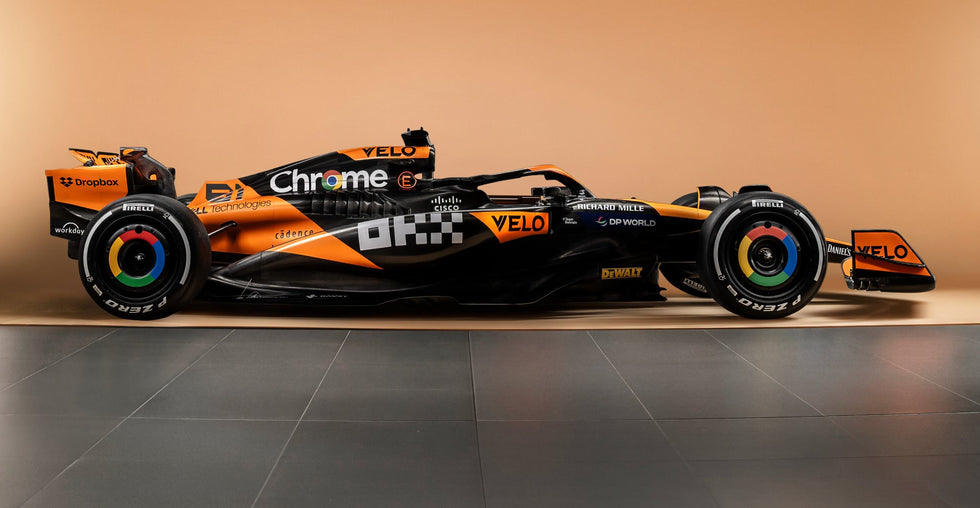
What the MCL38 has absolutely mastered is that the body panels have been tuned to within a millimeter or less to create the perfect boundary layer above 200 KPH (124 MPH). You want high downforce for cornering, which is where the wings at the front and rear come into play. However, as the car accelerates down the straight, the air moving over it wants a boundary layer of air so smooth to flow across that it creates little to no drag.
McLaren has found that perfect balance, and it shows with their speed, confidence in the corners, and the ability to brake at the absolute last moment. Once the McLaren gets clean air, it just enters another dimension of speed.
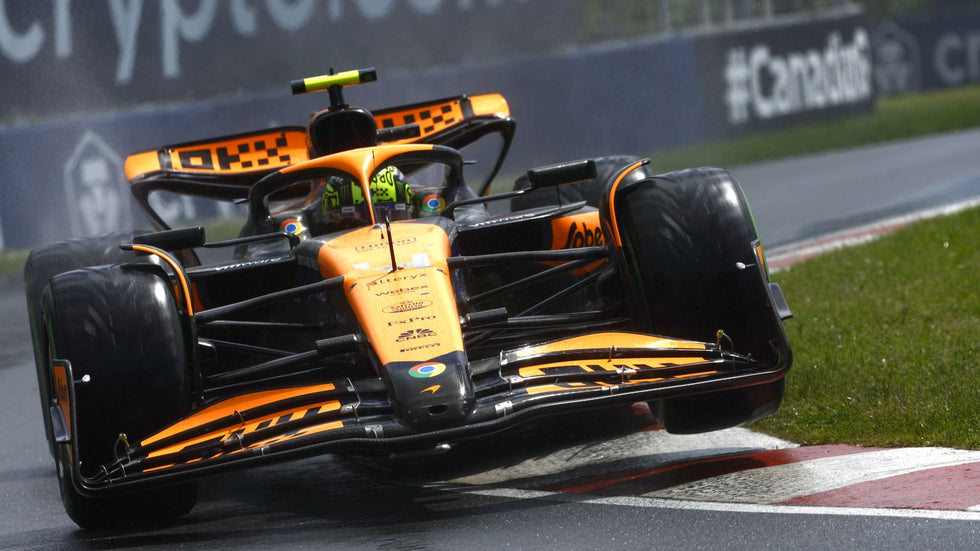
Wing & Floor Aerodynamics on the MCL38
Thankfully, wing aerodynamics are a much less complex bit of physics. They use the same principle of higher and lower pressure air—the best way to visualize this is to imagine the front and rear wings as upside-down airplane wings.
The front wing is designed to cause enough of a pressure difference in the moving air to shove the front of the car down. Once it reaches a certain point across the surface of the wing, the air is allowed to escape through the gaps between each wing element to flow down the car and into the ground effects tunnels (or over the body and sidepods).
The rear wing works by shoving the air upwards while allowing smoother air to flow underneath the wing and between the two wing elements. This causes downforce.
Where the MCL38 has mastered both the front and rear wing aerodynamics is that they have designed it to create just enough downforce without creating excess drag.
The MCL38 also has an interesting rear wing shape. The lower element of the wing is nearly flat—as it is with almost all the cars—but above that flat element is a moving upper element that pops up to become flat when the Drag Reduction System (DRS) is activated.
When the wing is down, there is a small 10mm gap between the elements. This causes the bulk of the air to be pushed upwards by the top flap, slowing it down. The air passing under the rear wing moves faster, and as explained earlier, that makes it lower pressure. A common misconception is that the wing pushes the car down, but in reality, the rear wing sucks the car down towards the road.
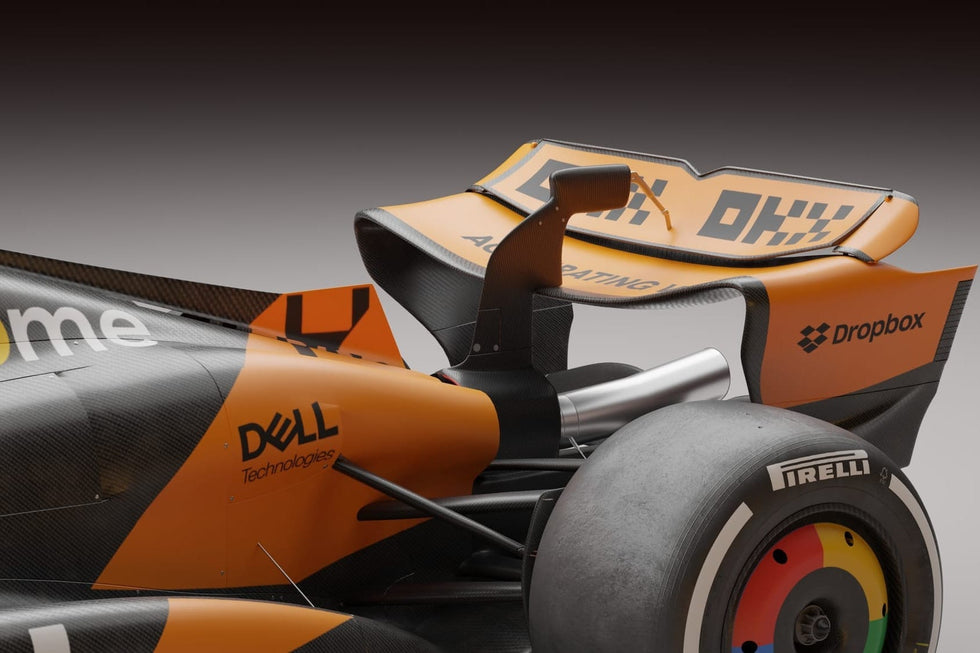
At speed, however, some air is allowed to escape between the elements and not add to the drag of the car—even with the DRS closed. This has been dubbed “Mini DRS”.
Even with all that, the wings and body of the car only really account for roughly 40% to 45% of the downforce an F1 car generates. The floor is the part of the car that guarantees at least 55% to 60% of the downforce (the cars are literally called “Ground effect” cars).
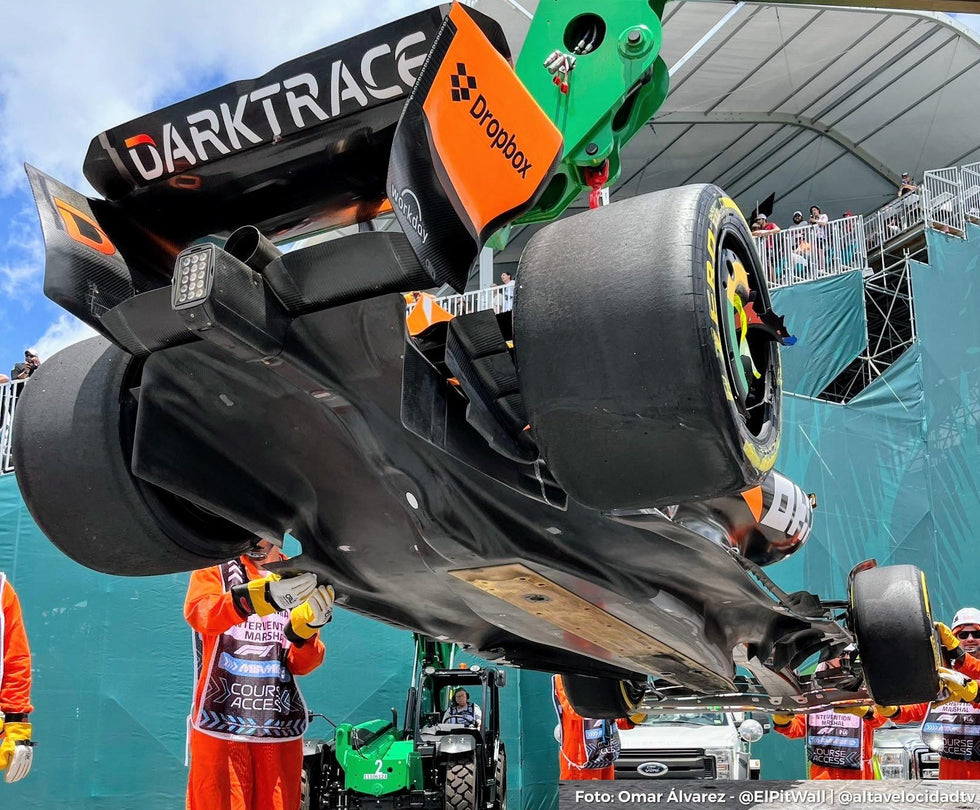
What happens is that the air passing through from the front wing gets directed into capture tunnels that start off tall and wide, but compress very quickly to almost the same level as the plank under the central floor of the car.
Some of the vanes in these tunnels will direct the compressed air out of the sides of the floor to create an “air curtain” along the side of the floor, while other vanes spread the air out under the floor of the car.
Where the MCL38 is leaving the others in the dust is that they have found the perfect balance between how much air to push out the sides and how much air to keep under the floor. This balance point is so incredibly fine, literally down to the thousandth of a percent, that it has taken them almost two years to find it. Now that they have it nailed, however, absolutely no other car on the grid can keep up with them when they run in clean air.
How These Features Translate to Sim-Racing
Many sims will allow you to adjust ride height, which we will go into much more detail about in a few moments, but the key point about this setting is that the floor of a racing car generates a significant amount of downforce. This is particularly important for Formula cars, IndyCars, prototypes, and even GT and NASCAR vehicles.
You can utilize the boundary layer effect in many simulators, including Assetto Corsa Competizione, iRacing, rFactor 2, Le Mans Ultimate, and Automobilista 2. Start a practice or free run session at a track featuring both high and low-speed sections. Spa-Francorchamps, Monza, and Silverstone are all great tracks for this activity.
Play around with the ride height and go for a few laps until you find the “burst point” where the car will suddenly start to not reach its absolute top speed of any of your runs.

Once you have figured out the ride height settings, it’s time to move on to adjusting the front and rear wings/splitters. This is why you want to test on a track with a mixture of high and slow speed corners such as Monza, which has a very long straight that ends in a hard 90-degree first turn into a chicane.
You want to have your front wing or splitter set to keep the front tires pushing into the road as you start your turn in, and then shift the car’s downforce backward to the rear wing so that when you exit the corner, your rear wheels grip the surface without spinning up.
It takes a lot of time to get the feel for it at first—a few days to a week of constantly playing around with it. Once you understand the relationship between underbody and overbody aerodynamics in a simulator, however, it will suddenly just click within your mind.
Once you get that feeling, you can very quickly set up your car for whatever track you’re on and get it right 90% of the time.
That was a lot of technical explanation, so let’s move on to something much less complex!
Chassis & Suspension
As mentioned above, body and wing aerodynamics are only part of what makes the MCL38 so fast. The other part is the suspension and its attachment points to the chassis.
Chassis
It’s quite rare to see the actual chassis of an F1 car, as it is buried under the surface panels. Imagine a long, square tube made of carbon fiber that includes the driver safety cell. Imagine it has an ovoid section between the rear crash structure and the driver’s seat. That whole structure, square tube, and ovoid section, is the actual core chassis of the car.
Everything is mounted to that tube, and it needs to be extremely strong and resilient to handle the forces an F1 car goes through.
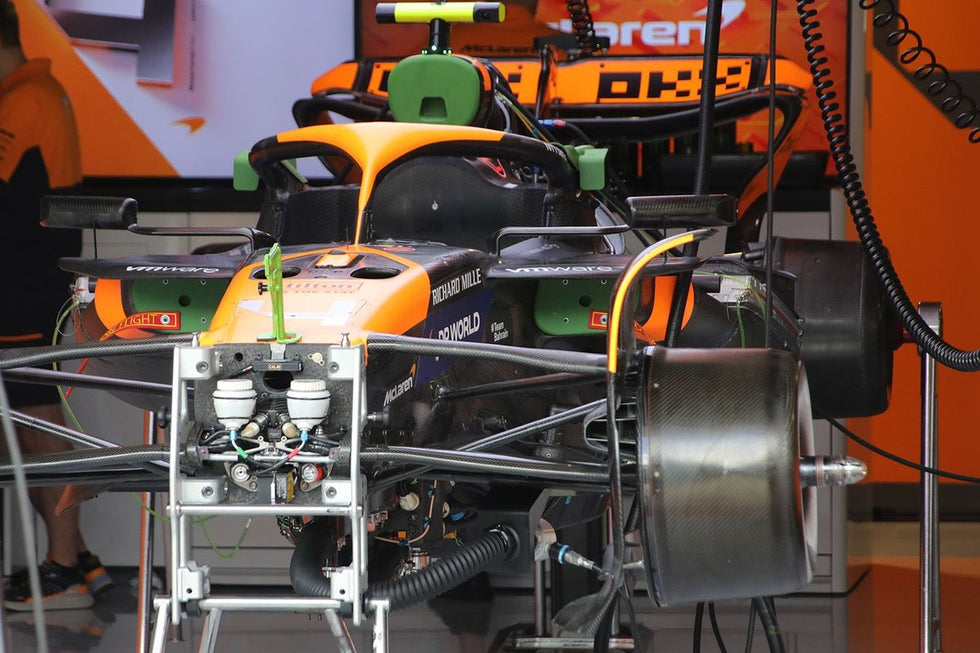
The chassis also supports the aerodynamic floor under the sidepods, but it’s most important for holding the engine and gearbox. Behind the driver’s seat and the fuel cell in its protective cage, the engine bolts directly to the chassis as a stressed member of the chassis, with the gearbox and the rear suspension then added as stressed members to the back of the engine.
It is this rigid structure that holds the secret to a perfect setup.
Suspension
On a road car or GT3 car, suspension usually has an upper and lower element holding a spring and gas-filled cylinder. This cylinder absorbs the nastiest bumps and lumps of the road, while the spring pushes the wheel down against the road.
On an F1 car, the suspension is not there for comfort. Instead, it is there to hold the car at its set ride height and flex just enough to keep the maximum surface amount of each tire in contact with the road at all times.
During the 2024 season, you may have heard on the commentary that the Red Bull RB20 car is known for being extremely stiff. This is because that car was designed to run as low as possible, which was the secret to its immense speed over the past two years.
Now that the car is running in traffic more than clean air, however, they’ve had to raise the ride height to allow it to remain competitive. This is where McLaren has the upper hand over pretty much everyone else.
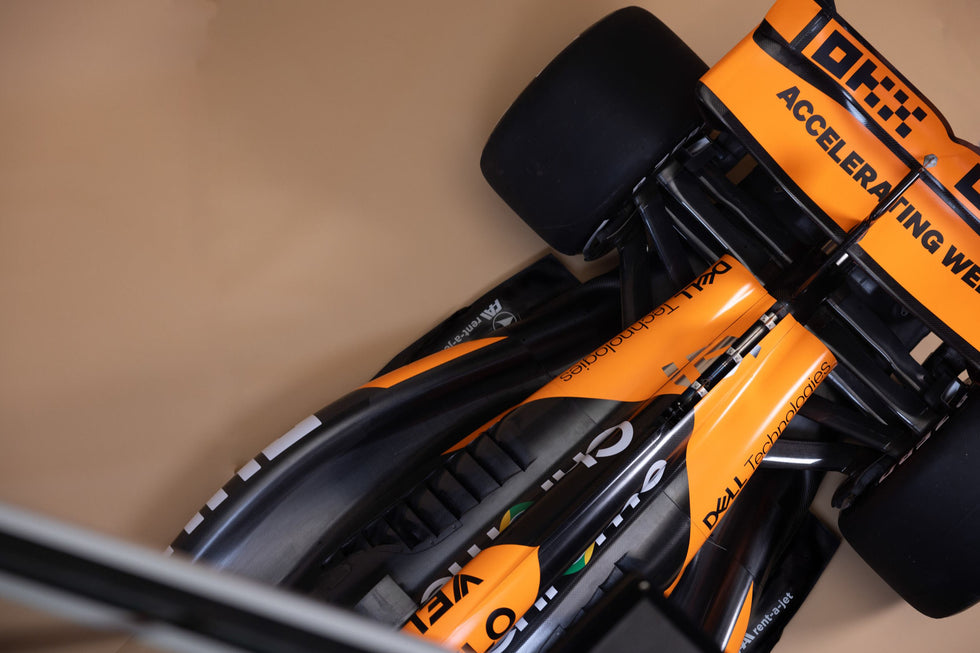
By understanding just how much rebound, flex, camber, and toe each wheel needs, they allow the car to ride a few millimeters above its lowest setting without it affecting the body’s aero performance. They also have a different layout compared to most other cars.
Of course, they have the upper and lower wishbones holding the wheel and brake assembly, but their damper and rebound arms go down into the chassis, instead of up across the top of the drivers’ legs where the damper springs are commonly located on other teams’ cars.
This allows for an extra amount of play in the rebound of the car. This is F1, so that play is measured in tenths of a percent, but the overall effect is that the MCL38 doesn’t bounce quite as much as other cars do, meaning the air passing over all the surfaces of the car isn’t as disrupted.
This is critical for the ground effect principle to work, and you can even hear the difference when F1 shows an onboard of the MCL38. With other cars, you’ll hear the scraping of the titanium skid blocks under the car coming and going with big gaps between scrapes. On the McLaren, you’ll hear little scrapes very close together.
That means the car isn’t bouncing nearly as hard and is having a smoother ride through the air compared to something as violent as the RB20.
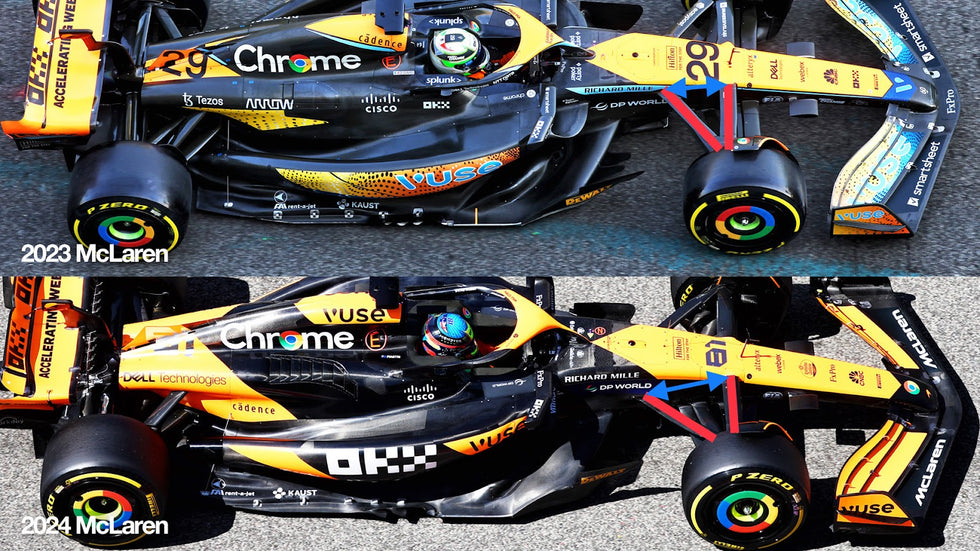
The other big thing about the MCL38’s unique suspension setup is that the rear arm of the top wishbone element is pushed as far back along the chassis as is allowed under the rules, nearly over the ground effect tunnels.
As each suspension component is covered with carbon fiber shaped like a flat wing, this positioning eliminates “dead air” between the front and rear arms of the front suspension.
How These Features Translate to Sim-Racing
While applying mostly to formula and indy cars in sim-racing, the basic principles can also be applied to GT cars and prototypes/hypercars. Here’s what to adjust:
- Ride height: The biggest setting to adjust is the ride height—you want the car to be riding at its absolute lowest without hitting the deck at the fastest point of any specific track.
- Suspension: As you adjust ride height, you will also need to adjust just how stiff the suspension and springs are, often winding on less rebound and higher compression settings. Much like the aerodynamics settings, finding the perfect balance will take many laps in a practice session.
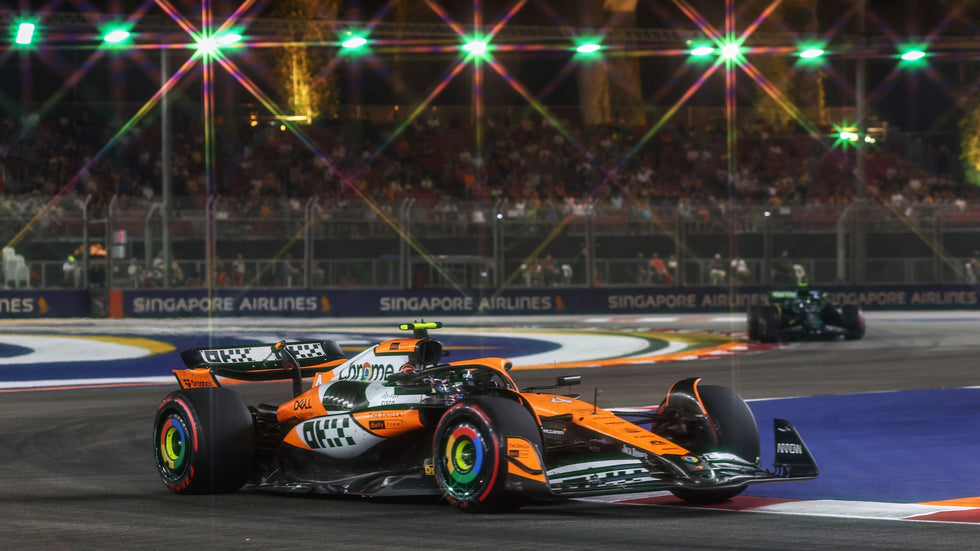
If you ride too low and set the suspension too stiff, the effect is that if you hit even the slightest bump, you’ll be likely to spin out or lose traction momentarily at a crucial point such as braking. You need to have enough bounce in the car to keep the tires absolutely smashed into the tarmac, but not so much as to look like a car on pogo sticks as you brake for a corner.
As silly as it sounds, this is definitely one setting that requires a good amount of feel, and sim-racers using direct-drive wheels do have a small advantage here due to the fineness of the force feedback that direct drive gives.
You really need to be dialed into how the car feels and handles. Then start adjusting things until you can turn in without understeer, hit a curb without being shot off the side of the road, and be able to accelerate like a bat out of hell without lifting the front of the car.
Engine & Specifications
Power Unit
Formula One engines are so complicated and involved that they aren’t even called engines—instead, they’re called “power units.” Among the most thermally efficient engines ever introduced into any form of motorsport, these 1.6L turbocharged V6 engines can extract more than 50% of the thermal potential of the race fuel that they use, and produce close to 1,000 HP when both the hybrid motor and the engine itself are used together during a qualifying run.
While they are capable of revving out all the way to 15,000 RPM, quite often they won’t go more than 12,000 due to fuel flow restrictions that prevent a team from dumping excess fuel into the system and gaining an unfair advantage.
One notable thing about McLaren is that they have never made their own F1 engine, instead preferring to buy from an engine supplier. At the moment, in 2024, the MCL38 uses a Mercedes-AMG F1 M15 E Performance unit, as can be seen in the Mercedes-AMG W15 F1 below.

This power unit encompasses a high-performance 1.6L turbocharged V6 pushing out somewhere around 840 HP, which has two hybrid motors attached to it that can fill in between 160 to 200 HP depending on engine mapping. These motors are the Motor Generator Unit - Heat (MGU-H) and Motor Generator Unit - Kinetic (MGU-K).
Both of these hybrid motors are attached to a lithium-ion power pack that can store a maximum of 4 MJ of potential energy. All of this is controlled via a system that is way too complicated to go into here—the Energy Recovery System (ERS).
Where the MCL38 is once again leading the pack is that it has several engine maps that extract the most power possible in each racing scenario without overpowering the car, as well as determining how much energy is recovered. For those who watch F1, you will see at points around the lap that the red lights on the back of the car flash, which is a warning to other drivers that the car in question is in harvesting mode.
McLaren has been able to set up several maps that use the hybrid power extremely efficiently, even along a massive straight like the 2-kilometer-long front straight at Baku, Azerbaijan. Look at this year’s race as an example, when Charles LeClerc was trying to chase down and pass Oscar Piastri. Whenever the view was from onboard the Ferrari, the MCL38’s lights only flashed at the very end of the straight as Piastri was braking.
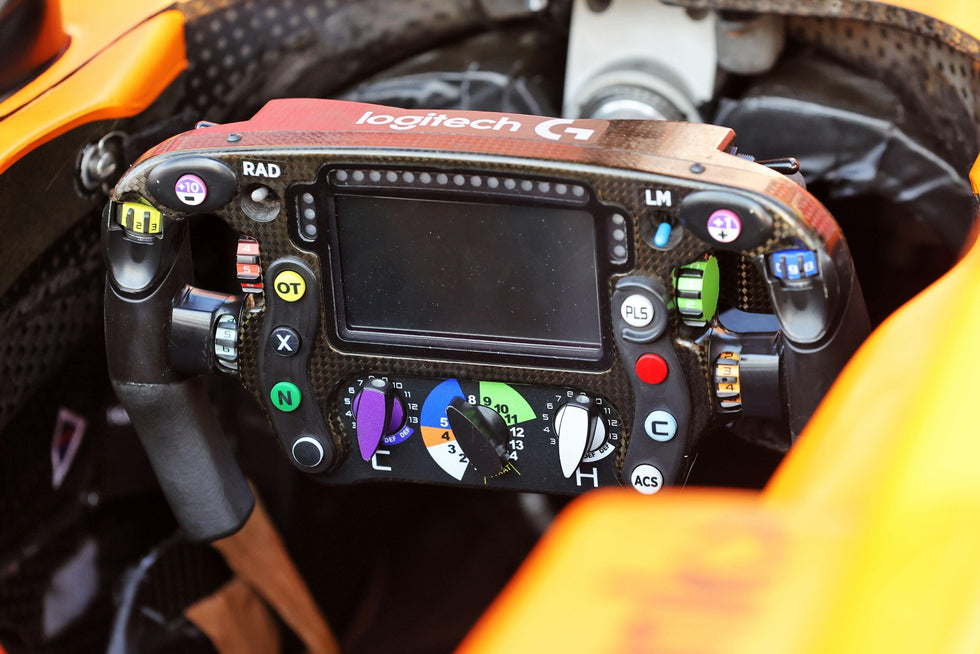
This mastery of the engine mapping is another reason that McLaren has suddenly surged from a middling position to be the team to beat now. The only thing that other drivers need to fear if they are ahead of Oscar or Lando Norris is whenever their race engineers radio out that McLaren is using the rare “Scenario 7.”
That setting is rare because it turns the engine and hybrid units up to maximum power, getting the full 1,000+ HP from the car at all times. It was most famously used by Lando in 2020 at Austria to get his first podium, as he needed to close up a gap of almost 2 seconds to get within a 5-second penalty range of Lewis Hamilton.
How These Features Translate to Sim-Racing
It really depends on what game or simulator you’re playing and if it allows you to change engine maps while driving. Games such as F1 2024 and iRacing do, as does Assetto Corsa Competizione. The biggest thing about setting up engine maps is that you really need to figure out what you want each map to do.
Most common sim-racers will have four engine maps (or simple variations on them) programmed:
- Warm-up or Outlap: deployed on the way out of the pits so that you don’t overstress the engine or deploy too much hybrid power.
- Qualifying: turns every setting up to maximum and a little more to give you the full deployment of the engine and hybrids for a one-lap blast.
- Race: generally set up with most settings between 90% to 95% of their maximum. Many simulators will also simulate overstressing your engine if you push it too hard.
- Pursuit: This map is usually 98% to 100% of available power. It gives you that little extra bit of grunt, but it also stresses the engine harder than the Race map.
The Outlap and Qualifying maps are used one after the other. When you come to the end of the Outlap, that’s when you will switch to Qualifying. You’ll then switch into Race for most of your session, and Pursuit when you need to chase down another car.
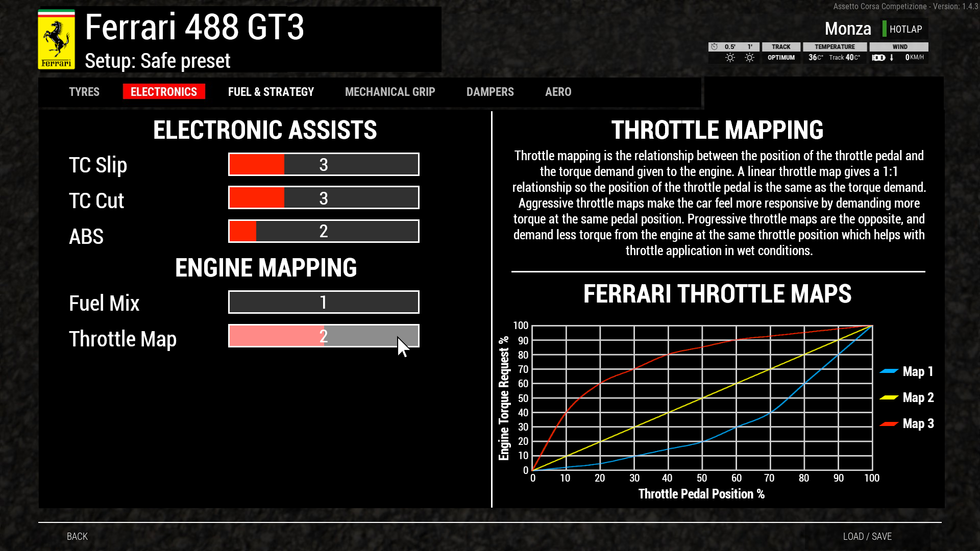
The thing about engines and engine mapping in simulators is just that: They are simulated. You can turn engine damage off and go 105% all the time, or you can set engine damage to “realistic” and after a lap at 105% get a warning that one of your cylinders is misfiring because it’s been overstressed.
There is no real set-in-stone guide as to how to map the engine to your preferences—but this is also part of what makes the difference between a merely good sim-racer and an excellent one.
New Innovations
We’ve already talked about one of McLaren’s best ideas for the MCL38: the Mini DRS gap in their rear wing to maximize their aerodynamic balance. But there are a few more to take note of as well.
Sidepods
One of the biggest innovations we haven’t covered yet also relates to aerodynamics, which is the “Waterslide gulley” shape of the sidepods of the car.
Due to the shape of the engine cover and the location of the cooling slats that use the air passing over them to suck heat out of the engine bay, the sidepods of the MCL38 slope down gradually with a somewhat wide and deep trough that leads all the way down to top of the floor just before the rear wheels. They start out flat at the top, then dive down and narrow by the bottom of the pods.
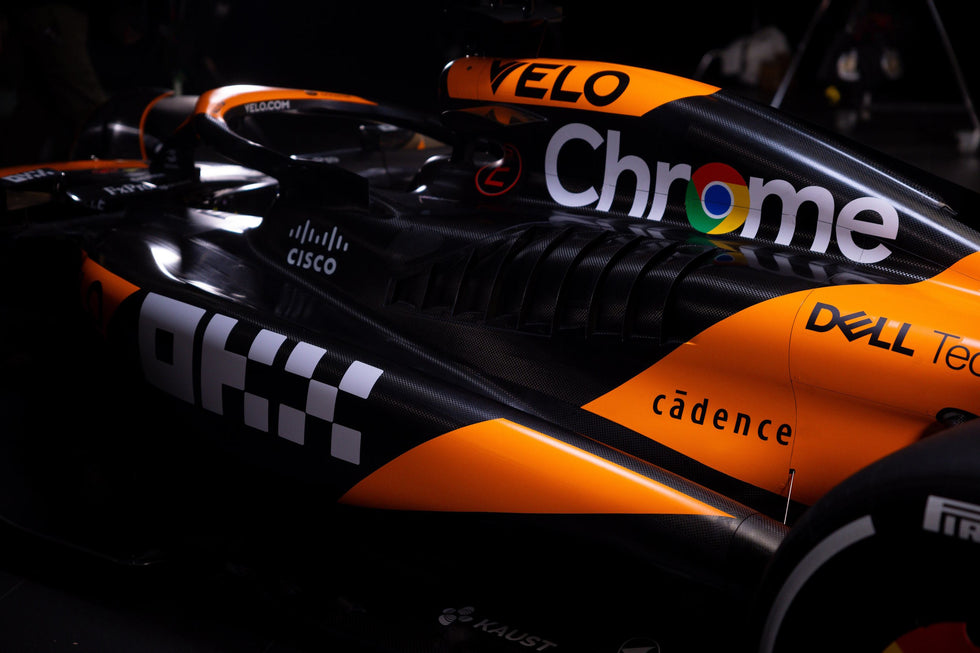
What’s so special about this gulley?
It has to deal with how the MCL38 forms its boundary layer. The trough is shaped in a way that as the air reaches the base of it, it starts to spin inwards towards the car. All of the F1 cars do this in some form or fashion, but what sets the McLaren apart is that it has shaped the trough to prevent as much outwash as possible.
Outwash, in a simple definition, is when air is uncontrolled and “washes” away from the car. It may not sound like much, but even a small amount of unexpected air hitting the front of the rear tires can cause a difference of a tenth of a second per lap.
F1 cars are akin to scalpels. When they are sharp and perfect, they slice the air with ease. If they even have a small bit of dullness, they will still cut, but with a little resistance.
Steering System
There haven’t been too many new tech innovations for the last couple of years, since much of that is controlled by the FIA and is out of teams’ hands. The last time we saw anything truly groundbreaking and innovative was with the Mercedes-AMG DAS (Dual Axis Steering) system in 2020, which allows the driver to pull the steering column to change toe angle.
Since then, the FIA have been pretty stern on keeping things for the 2022 to 2026 era status quo. However, that doesn’t mean that they don’t have some very capable biological control units behind the wheel—aka the drivers. And when you’re racing this car in a simulator, that’s you.
Why McLaren’s Driver Lineup Is The Envy of the Grid
2024 is Lando Norris’s fifth season with McLaren, and Oscar Piastri’s second. That means that for the MCL38, both drivers were able to give their input, do simulator runs at the factory, and help refine things from the very strong end of the 2023 season and the MCL37.
Lando Norris

Once a wide-eyed, comedic rookie, Lando has matured over the past few seasons into one of the fiercest and capable drivers on the grid. He still will crack a joke at every opportunity he can, but as is being seen in the second half of the 2024 F1 season, he really is no joke and can drive the absolute nuts off the MCL38.
In the past, there have been flashes of brilliance—such as Sochi 2020, when he was beating Lewis Hamilton and only lost the race because he made the wrong call on tires. He came very close to winning a couple of races in 2023, and at Silverstone, he even led the race for most of the first lap. There was a sense that something special was coming, and that finally materialized at Miami in 2024 with his first win.
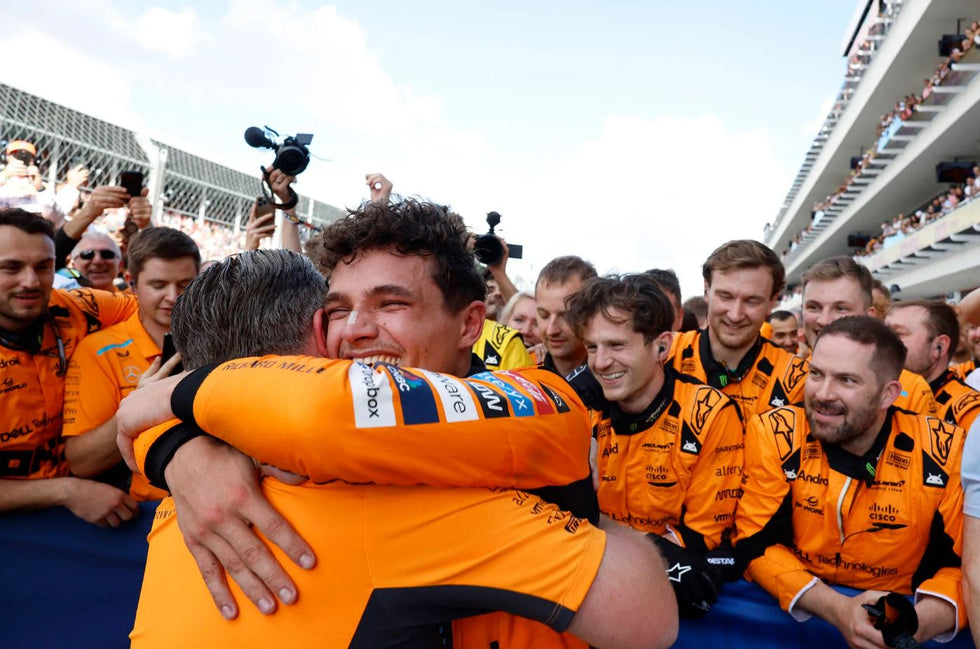
With that huge weight off his shoulders, he has exploded into a true championship-capable driver. He has a driving style that is both aggressive yet smooth, turning the car in hard to corners, but not jerking the wheel to do so.
With that driving style, the loading up of the tires and the weight shift of the car is progressive and controllable, which in turn saves the tires a lot of wear and tear. He is very quickly developing a reputation of being a “tire whisperer,” able to make a tire last 5 to 15 laps longer than it really should while also sometimes setting the fastest laps.

He truly is becoming one of the most desirable and capable F1 drivers in many years. In fact, as of this writing, he is the only driver with a mathematically possible chance of beating Max Verstappen for the Drivers’ Title, if he wins every single race between now and the end of the season and Verstappen places third or worse at two of those rounds.
That is why this is becoming one of the best second halves of a season since 2021—and the back-and-forth battle between Hamilton and Verstappen.
Oscar Piastri
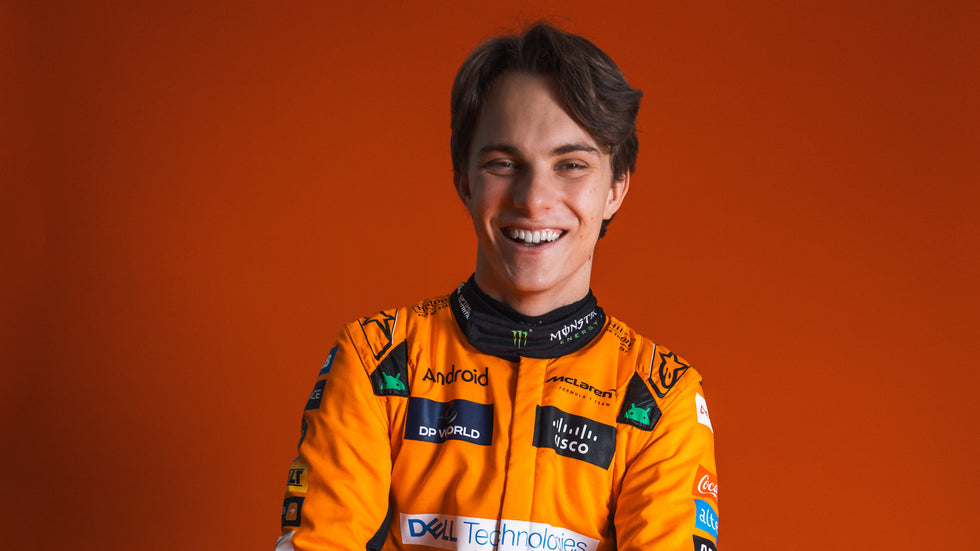
If you ever wondered what would become of the quiet kid at the back of the class in school that everyone respected but no one really knew much about, look no further than Oscar.
Making enough of an impression in junior formulas and karting to get noticed, it wasn’t until he turned 18 that he unleashed his full talent. He absolutely decimated the Formula Renault Eurocup championship, winning it with 320 points. That earned him both a signing to the Alpine F1 (at the time Renault) junior roster, as well as a promotion to Formula 3, which he won with 164 points.
Since the champion of F3 has to move up to F2, he did—and decided that he’d just go ahead and win that championship with 252.5 points. He obliterated three highly competitive championships, each time during his rookie year, back to back to back. He set a record as the only driver to win all three championships in his rookie year.
He was expected to make the F1 grid in 2022, but BWT Alpine F1 had already secured their lineup, and Piastri was relegated to a reserve and test driver position.
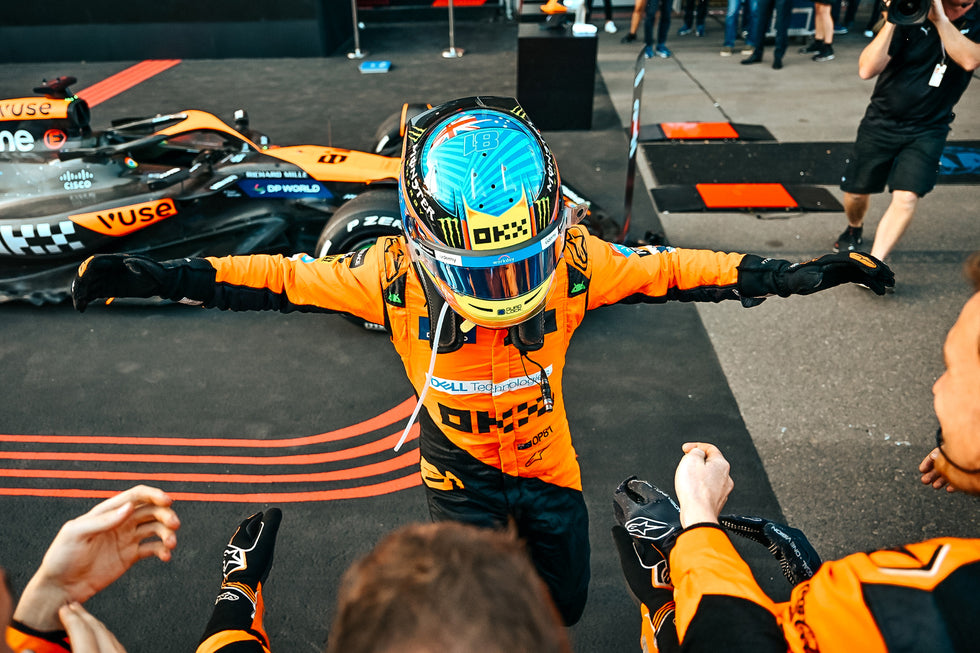
Alpine really missed out on a special talent, however, because due to losing track of when his junior contract expired, they tried to promote him to a 2023 F1 seat a couple of days late. Mark Webber, former F1 driver, and Oscar’s manager and agent, made the contract signing of the year when Piastri was brought over to McLaren in the summer of 2022, immediately becoming their reserve driver.
In 2023, he made his F1 debut with McLaren, and from the very first race, there was a sense that he was a generational talent. This proved to be true when he won the Qatar sprint race in a McLaren that was (at the time) technically inferior to the Red Bull RB19.
He also secured his first win in 2024 at Hungary, and then put on a complete masterclass of defensive but fair racing for almost the entire race at Baku, including doing the dive bomb of all dive bombs to pass Charles LeClerc for the lead from half a second back.
Keep in mind, this is Oscar’s second season in F1. Not even Verstappen had his first win until he was three seasons into his career. Oscar is also hilariously deadpan on the radio, sounding like he’s bored out of his skull on a Sunday cruise down the highway instead of screaming along at 300 KPH or more. He is also not at all physically imposing—in fact, he still seems like that same kid at the back of the class. But under it all, he is one of the best drivers F1 has seen in years.
Race in F1 Yourself in Our Simulators
With the Formula One season winding down, many simulator games are getting their 2024 car packs together for release. While we don’t have the McLaren MCL38 F1 (yet!) in our primary simulators, we do have the 2023 MCL37 available to drive right now.
You can get a taste of it with our Intro To F1 experience, a one-hour session that is the perfect introduction to simulator racing and virtual reality. If you’ve already done that course, then you can come and race with any of our packages, from the Flat 60 hotlapping or single race session, to a challenge against three of your best friends in the Four on the Floor package.
Just remember, Formula One is the pinnacle of track racing motorsports. It is fast, technical, and a hell of a lot of fun from inside the cockpit. Book your session now to experience it for yourself!

